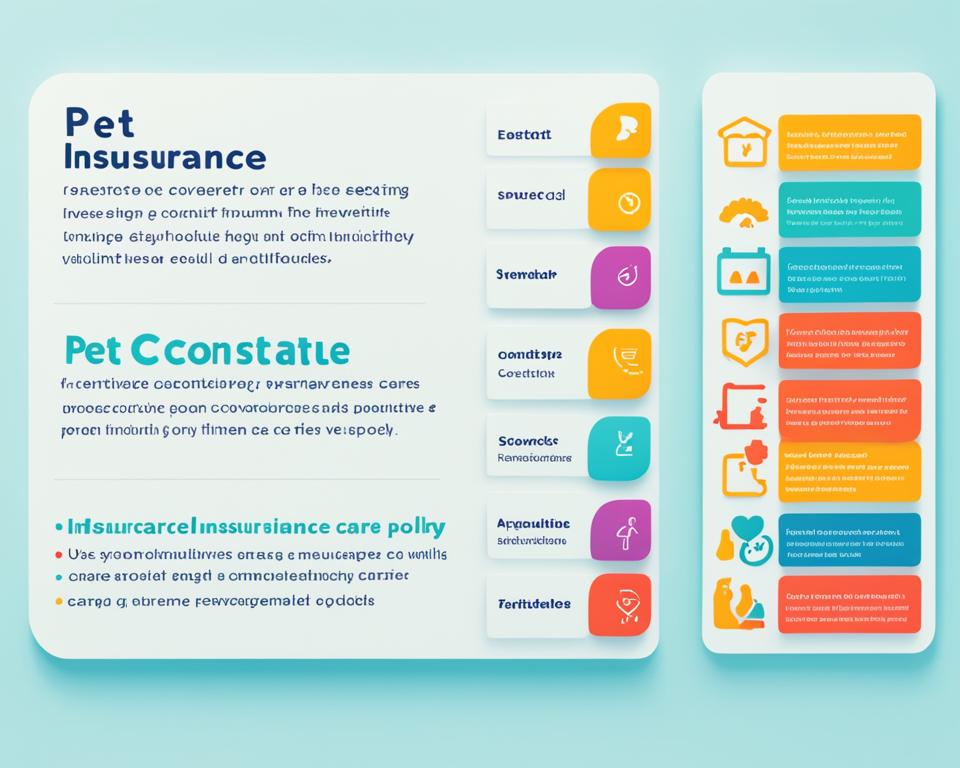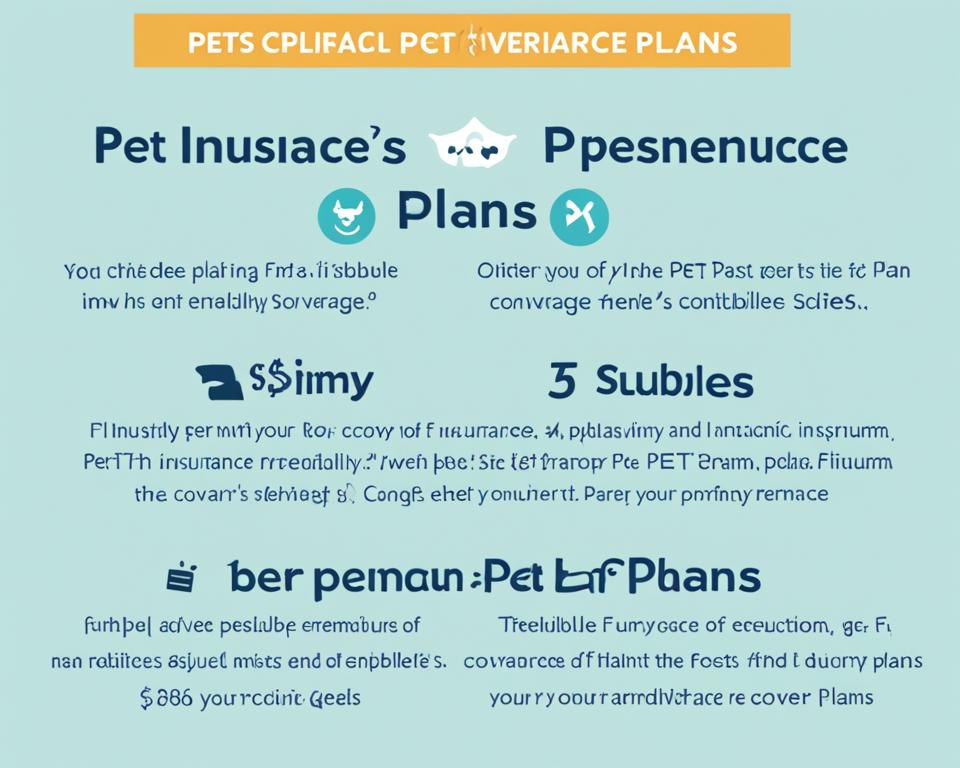I always thought our pets should get the best care. That’s why I’m excited to share about pet insurance. It helps protect your furry friend. Over 600,000 dogs and cats got insured through the ASPCA® Pet Health Insurance program in the last 20 years.
Animal medical plans come in many options for different needs and budgets. You can pick from accident-only to full coverage plans. These plans include illnesses, dental care, and even behavioral issues. You can customize them to fit your pet’s needs.
Pet insurance is flexible. You can take your pet to any vet in the U.S. or Canada. And, you can get up to 90% back on eligible costs. This lets you focus on your pet’s health, not the bills.
It’s not just for emergencies. Many plans cover routine care like vaccines and dental cleanings. There are no age limits or breed restrictions. So, it’s never too late to start protecting your pet.
Understanding Pet Insurance Coverage Options
Pet insurance has many options to keep your furry friend healthy. Let me explain the main types of coverage. This will help you choose the best pet wellness policies.
Accident and Illness Coverage
This basic coverage helps with unexpected injuries and illnesses. It covers things like ACL ruptures, poisonings, and ear infections. Even serious issues like cancer are covered.
Comprehensive Plans
Comprehensive plans give more protection. They include accident and illness coverage and more. Some cover hereditary conditions, behavioral issues, and even acupuncture.
These plans can cut down on your pet’s healthcare costs.
Customizable Policy Features
Most pet insurance plans can be tailored to your budget and needs. You can choose:
- Annual coverage limits (from $5,000 to $100,000)
- Reimbursement percentages (70%, 80%, or 90%)
- Deductible amounts ($100 to $750)
Higher coverage limits and reimbursement percentages mean higher costs. Finding the right balance can help you pick the best plan for your pet and your budget.
Key Terms in Pet Insurance Policies
Looking into veterinary cost coverage for your pet can be confusing. I’ve made a guide to help you get the key terms.

First, let’s talk about coverage types. Over 98% of pet insurance plans are for Accident and Illness Coverage. This keeps your pet safe from unexpected injuries and sicknesses.
Pre-existing conditions are something to watch out for. These are health issues your pet had before the policy started. Most insurers won’t cover them. So, it’s best to get insurance when your pet is young and healthy.
| Term | Definition | Impact on Coverage |
|---|---|---|
| Waiting Period | Time before coverage starts | Typically 14 days for illness |
| Annual Limit | Maximum yearly payout | Varies by policy |
| Deductible | Amount you pay before insurance kicks in | Often $100, $250, or $500 |
Knowing these terms can help you pick the right insurance for your pet. Policies vary, so always read the details!
Common Exclusions in Pet Insurance Plans
When looking into pet health coverage, it’s key to know what’s not covered. Most policies have exclusions that pet owners should know about before signing up.
Pre-existing Conditions
Pet insurance often doesn’t cover pre-existing conditions. These are health issues your pet had before the policy began. Some insurers might consider covering it if your pet is symptom-free for about 180 days.
Hereditary and Congenital Disorders
Coverage for hereditary and congenital disorders varies by pet health coverage provider. Some plans don’t cover these at all. Others might offer limited coverage. Always read your plan’s details carefully.
Chronic and Ongoing Conditions
Many pet insurance policies cover chronic conditions when symptoms first show up in a year. But, coverage for these conditions in later years can be hard to figure out. Some insurers offer special endorsements for ongoing care of these conditions.
| Common Exclusions | Details |
|---|---|
| Pregnancy and birthing costs | Most policies don’t cover cesareans or related expenses |
| Routine vaccines | Often considered preventative care, not covered by standard plans |
| Grooming and boarding | Non-medical services typically not covered |
| Behavioral training | Not seen as a medical need by most insurers |
Knowing about these exclusions helps you pick the right pet health coverage. Remember, each plan is different. Always check the policy details well before deciding.
Waiting Periods and Their Importance

When I looked into pet insurance, I learned that waiting periods are key. They change based on the coverage and the company. For accidents, waiting times are usually 1 to 15 days. For illnesses, it starts after 14 days.
Pet wellness plans often have no wait, covering routine care right away. But, for certain issues like cruciate ligament problems or hip dysplasia, you might wait 6 months to a year.
Here’s what you can expect for waiting times:
- Accidents: 1-15 days
- Illnesses: 14-30 days
- Orthopedic conditions: Up to 6 months
Some companies offer special perks. Embrace, for example, cuts the wait for orthopedic issues to 14 days with an early exam. ManyPets can make the wait for accidents and illnesses just 24 hours if you come from another insurer.
It’s key to know about these waiting times for good pet insurance planning. Insuring your pet early helps avoid long waits and pre-existing condition exclusions. This way, your pet gets full protection from the start.
How Pet Insurance Claims Are Processed
Understanding how pet insurance claims work helps pet owners make smart choices. The process includes steps like figuring out costs and how much you’ll get back.
Usual and Customary Cost Determination
Pet insurance companies look at industry data to set fair prices for pet care. This makes sure different treatments and procedures cost fairly.
Reimbursement Calculations
Insurance usually covers 70% to 90% of your pet’s medical bills. Here’s how it works:
- First, subtract the deductible from the bill.
- Then, apply the co-insurance percentage.
- Finally, figure out your final reimbursement.
Claim Submission Process
Now, submitting a claim is easy thanks to technology. Insurers offer online portals and apps for quick claims. You can upload bills and check your claim’s status online. Some even offer direct deposit for faster money.
Most pet insurance plans have a waiting period before they start covering your pet. This is to avoid claims on conditions your pet had before getting insurance. Claims usually take about two weeks to process, but this can change.
“Pet insurance has streamlined my veterinary expenses. The claim process is straightforward, and I appreciate the quick turnaround on reimbursements.”
You can send in claims for any care from any vet. You don’t have to stick to a certain network. This makes it easy for pet owners everywhere in the U.S.
Pet Insurance: Choosing the Right Plan for Your Pet
Finding the right pet insurance can be hard. I think about coverage options, deductibles, and policy limits a lot. When picking a plan for my pet, I looked at her age, breed, and health risks.
Costs for vet care vary a lot. Clinics in cities often charge more because of higher costs. I found out that cats are cheaper to insure than dogs. The cost to insure different dog breeds can also change because of their health.

Here’s a comparison of two sample plans for a four-year-old Labrador Retriever:
| Plan | Monthly Premium | Reimbursement | Annual Limit |
|---|---|---|---|
| Basic | $34.95 | 70% | $5,000 |
| Premium | $52.95 | 90% | $10,000 |
Higher deductibles and co-insurance often mean lower premiums. Some insurers offer discounts for more pets and cover exam fees. But, no plans cover conditions your pet had before you got insurance.
Choosing the right plan means balancing cost and coverage. By thinking about these things, I make sure my pet gets great care without spending too much.
Deductibles and Co-Insurance in Pet Insurance
When I look into pet insurance, I see deductibles and co-insurance are key. They change how much I pay and how my policy works.
Annual Deductible Options
Pet insurance deductibles can be from $0 to $1,000. Most people, like me, pick a $250 annual deductible. This means I pay the first $250 of vet bills each year before insurance helps.
Some companies offer deductibles for each visit, but yearly ones are more common.
Co-Insurance Percentages
Co-insurance, or reimbursement rate, is what my insurer pays after I meet my deductible. It’s usually around 80% of the covered vet bill. For example, with a $500 deductible and 80% reimbursement, I’d pay $672 on a $1,360 vet bill.
The remaining 20% is my copayment.
Impact on Premium Costs
My choice of deductible and co-insurance changes my monthly premium. A lower deductible means higher premiums, while a higher deductible lowers my monthly cost. For instance, a policy with a $100 deductible might cost $63.05 per month.
But with a $1,000 deductible, it could drop to $19.06. I need to balance my budget with potential out-of-pocket expenses when picking my pet insurance plan.
Policy Limits and Coverage Maximums
When I look for animal medical plans for my furry friend, I must understand policy limits and coverage maximums. These can change a lot between providers. They affect how much coverage and cost you get.
Many pet insurance companies offer limits from $2,500 to $30,000 a year. For example, Embrace has options from $5,000 to $30,000. SPOT offers choices between $2,500 and unlimited coverage. Trupanion has an unlimited payout, giving pet owners peace of mind for big vet bills.
When picking a plan, I think about my pet’s needs and my budget. A yearly limit of about $10,000 usually covers most pets’ emergencies. But, remember, higher limits mean higher premiums.
Reimbursement rates are usually 70% to 90% after the deductible. This means hitting the yearly limit means big vet bills. For instance, with a $10,000 limit and 80% reimbursement, my out-of-pocket costs could be $2,000 before hitting the limit.
Some plans offer unlimited coverage, which is great for pets with ongoing health issues. These plans cost more but protect against big vet bills.
Choosing the right limit means balancing your pet’s needs, your budget, and future costs. It’s smart to compare different providers to find the best for your pet.
Wellness Care and Preventive Coverage Options
Pet wellness policies change the game for pet healthcare costs. They cover routine care, keeping your pet healthy and happy. Adding wellness coverage to your pet insurance can save you money over time.
Routine Care Benefits
Wellness plans cover yearly check-ups, shots, and preventive treatments. Many pet owners feel at ease with these plans. They make sure you catch health problems early with regular vet visits.
Vaccinations and Annual Check-ups
Keeping your pet’s shots current is key for their health. Wellness plans often pay for important vaccines like rabies and DHLPP. They also cover yearly check-ups to keep an eye on your pet’s health.
Dental Cleaning Coverage
Dental health is crucial for pets but often ignored. Some wellness plans pay for dental cleanings, which can stop big health problems later. Regular cleanings can also save you from expensive dental work later.
| Service | Defender Plan | DefenderPlus Plan |
|---|---|---|
| Wellness Exam | $50 | $50 |
| Rabies Vaccination | $15 | $15 |
| Total Benefit Value | $305 | $535 |
| Monthly Cost | $15 | $28 |
| Annual Savings | 33% | 35% |
Wellness plans can cut down on pet healthcare costs. They offer great value with prices from $10 to $35 a month. Remember, spending on preventive care now can save you from big bills later.
Comparing Pet Insurance Providers and Plans
When I look for pet insurance, comparing different providers and plans helps a lot. There are about 20 pet insurance companies in North America. I start by looking at coverage options, exclusions, waiting periods, and claim processing times.
Some providers stand out. For example, Embrace Pet Insurance paid out 92% of claims in 2021. They offer up to 90% reimbursement on vet bills. ASPCA Pet Health Insurance has a Complete Coverage℠ plan for dogs and cats.
Pets Best processes claims quickly, usually within five days. Figo Pet Insurance even offers an optional 100% reimbursement rate after meeting the deductible.
To make my decision, I look at the average costs. For dogs, pet insurance costs about $48 per month for $5,000 annual coverage with an 80% reimbursement level. For cats, it’s around $28 per month.
I also check for discounts. Pets Best offers a 5% multipet discount. Embrace gives a 10% annual pay discount. By comparing these factors, I can find the best veterinary cost coverage for my furry friend.

